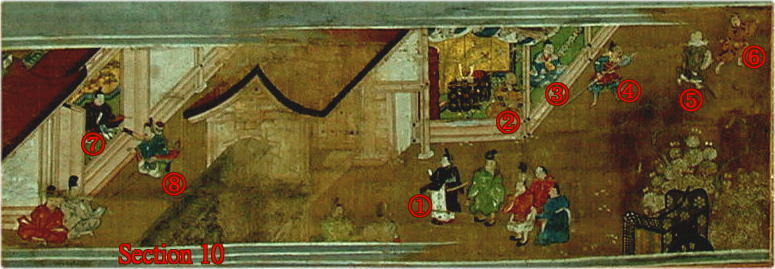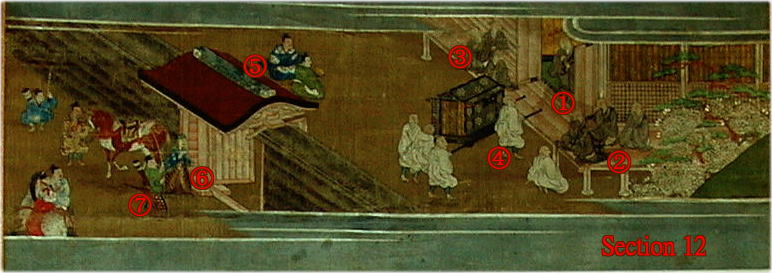An Illustrated Biography of Shinran, the Honganji Shonin
(Honganji Shonin Shinran Denne)
Compiled by Kakunyo
Introduction, translation and notes
by Zuio H. Inagaki
Go to Index to Shinran denne;Sukhavati-Index; General Index
9
With the flourishing of the Pure Land teaching,
the Path of Sages dwindled in influence.
Enraged scholar-monks in Nara and on Mt.
Hiei held Master Genku responsible for this
and appealed to the court for his expeditious
punishment. It is stated in A Collection of Passages Revealing the Provisional
Transformed Buddhas and Lands of the Pure
Land Way, Chapter 6:
When I humbly contemplate matters, I find
that in the various teachings of the Path
of Sages, both practice and enlightenment
have long become impossible to realize and
that the true teaching of the Pure Land way
is now flourishing as the sure way to Enlightenment.
Despite this fact, monks of various temples,
being blind in discerning the teachings,
are unable to distinguish the true way from
the provisional way. Confucian scholars in
the capital, being confused about practices,
cannot tell the difference between the right
and wrong paths. Thus, scholar-monks of Kofukuji
temple presented a petition to the retired
emperor [Gotoba-in] (Takanari by name) in
the first part of the second month in the
year fire/hare of the Jogen era(1) during the reign of emperor [Tsuchimikado-in]
(Tamehito by name).
Lords and vassals who opposed the Dharma
and justice harboured indignation and bore
resentment [to the Nembutsu teaching]. Thus,
Master Genku, the great founder who promulgated
the true teaching of the Pure Land way, and
a number of his followers were, without proper
investigation of their crime, indiscriminately
sentenced to death or, deprived of their
priesthood, exiled under criminal names.
I was one of them. Hence, I am neither a
priest nor a layman, and so I took 'Toku'
as my surname. Master Genku and his disciples
spent five years in remote provinces in exile.
The criminal name of Genku Shonin was Fujii-no-Motohiko,
and the place of his exile was Hata in Tosa
Province. The criminal name of Shinran Shonin
was Fujii-no-Yoshizane, and the place of
his exile was Kokubu in Echigo Province.
I will not enumerate other disciples' death
charges and exiles.
On the seventh day of the eleventh month
in the first year of Kenryaku, the year metal/sheep(2), during the reign of Emperor [Sado-no-in,
Morinari by name], the imperial order to
pardon Shonin was issued through Lord Okazaki
Norimitsu, the Middle Counsellor at the Court.
At that time, Shonin's name, with 'Toku'
(short-haired) as the surname, was announced
to the Emperor; this impressed the Emperor
and won the praise of his attendants. Even
though Shonin was pardoned, he continued
to stay on to convert country-folk.
Notes:
1. This corresponds to 1207, when Shinran
was 35.
2. This corresponds to 1211, when Shinran
was 39.

Section 10 At the gate of the Imperial Palace
1. A court noble, Lord Chikatsune, walking
toward the main gate.
2. Probably Soncho of the Office of Temples
and Shrines.
3. The police inspector, Motokuni.
4. Detective, Suesada, chasing Juren and
others.
5. Juren who was charged and executed.
6. Juren's attendant.
7. Chikatsune, who acted as prosecutor, passing
the sentence.
8. Sasaki Saburo respectfully receiving the
sentence.

Section 11Court nobles' meeting
1. Jinjuden Hall in the Imperial Palace.
2. Court nobles discussing the charges against
Honen and his disciples.

Section 12 Honen's exile.
1. Honen about to leave his hermitage for
his destination in Tosa Province, Shikoku
Island.
2. Honen's disciples shedding tears of sorrow.
3. Another group of his disciples.
4. The palanquin-bearers.
5. Lay disciples seeing off Honen.
6. Police inspector, Hisatsune.
7. Police officer, Taketsugu, going to escort
Honen to Shikoku.

Section 13 Shonin's exile at the age of 35.
1. Shonin boarding a palanquin at his hermitage.
2. The palanquin leaving for Echigo Province.
3. Shonin's disciples shedding tears of sorrow.
4. Saibutsu-bo.
5. Ren'i-bo.
6. Police inspector, Otsuki Yukitsura, .
7. Police officer, Minamoto-no-Akikane, going
to escort Shonin to Echigo.
8. Asakura Shuzen sent here to attend Shonin
by Lord Kujo Kanezane.
10
Shonin moved from Echigo over to Hitachi
Province, and settled down at Inada Village
in Kasama County. Although he lived in retirement,
priests and laypeople followed one after
another to visit him; even though the lowly
gate was closed, people, both high and low,
crowded the cottage. Shonin's cherished desire
to spread the Buddha-Dharma was thus fulfilled,
and his long-standing wish to benefit sentient
beings was quickly realized.
Shonin remarked, "The dream of the bygone
days in which I received an inspiration from
the World-saving Bodhisattva exactly fits
what is happening now."

Section 14 Spreading the Dharma in the countryside.
<Right> In Kokubu and its surrounding
area.
1. Shonin on his missionary tour in the snow
along the Japan Sea coast.
2. Saibutsu-bo.
3. Ren'i-bo.
4. A factory for producing salt.
<Left> At Inada in Kanto district.
1. Shonin's hermitage at Inada.
2. Shonin.
3. Saibutsu-bo.
4. Shoshin-bo.
5. Local people coming to listen to the Dharma.
11
As Shonin spread the teaching of the exclusive
practice of the Nembutsu in Hitachi Province,
those who doubted and abused it were few,
and many accepted it in faith. However, there
was a monk [said to be a yamabushi(1)], who bore a grudge against the Buddhist
teaching [Shonin was promulgating], culminating
in an attempt to kill him; thus he was seeking
an opportunity to realize this.
Shonin often passed through a deep mountain
called Itajiki-yama. On that mountain the
yamabushi waited for him in ambush many times, but
was unsuccessful. As he contemplated the
cause of this failure, he was struck with
a rare, strange thought. Thereupon, he decided
to go and see Shonin. When he called at the
hermitage, Shonin came out without hesitation.
As soon as he saw Shonin's august countenance,
his vicious intention quickly disappeared
and, furthermore, he could not hold back
tears of regret and shame.
After a little while, he confessed to Shonin
the grudge that he had entertained against
him. Shonin, however, did not appear surprised.
The yamabushi broke his bow and arrows on the spot, threw
away his sword and stick, cast away his hood,
and took off his persimmon robe. As a result
of this transformation, he thus took refuge
in the [true] Buddhist teaching, and finally
fulfilled his aspiration for birth in the
Pure Land. What a wonderful thing! He was
later known as Myoho-bo; this is the name
given to him by Shonin.
Note:
1. 'Yamabushi,' literally 'mountain sleeper'; a follower
of mountain Buddhism (shugendo); so called because he lives in the mountains
while engaged in ascetic practices.

Section 15 Conversion of Bennen.
<Right> Bennen trying to kill Shonin
on the mountain path.
1. Bennen's men.
2. Bennen waiting for Shonin's coming.
<Left> Bennen's conversion.
1. Shonin at the age of 49 greeting Bennen.
2. Bennen at the age of 38 confronting Shonin.
3. Shonin seated in the house.
4. Bennen becoming Shonin's disciple and
receiving the Buddhist name, Myoho-bo Shoshin.
5. Saibutsu-bo and Ren'i-bo.
 Go to Next File; return to Index to Shinran denne;Sukhavati-Index; General Index
Go to Next File; return to Index to Shinran denne;Sukhavati-Index; General Index







![]() Go to Next File; return to Index to Shinran denne;Sukhavati-Index; General Index
Go to Next File; return to Index to Shinran denne;Sukhavati-Index; General Index